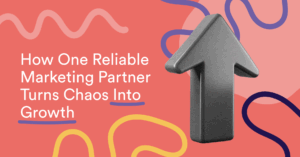How One Reliable Marketing Partner Turns Chaos Into Growth
Tired of vendor bingo? Discover how one reliable marketing partner, flat fees, and a 30-60-90 roadmap can turn chaos into clear, predictable pipeline growth.
Read more
Nando’s knows the power of brand marketing; after taking a knock during COVID-19, how else would a company that sells chicken race up the brand ranking charts in 2024?
Product vs Brand: The Only Two Types of Marketing
At Growth Experts, we’ve been analysing our “all-you-can-eat marketing” promise lately. It’s made us think hard about what we’re truly offering our clients. Are we clearly showing them how we deliver results, or are we just promising them an endless buffet without describing the dishes?
This led us down a fascinating path of examining how companies present themselves.
After analysing hundreds of websites and campaigns, we’ve reached a simple but powerful conclusion: there are only two main types of marketing – Product-led and Brand marketing.
Everything else is just tactics.
The Fascinating World of Brand Metrics
When we talk about brand marketing, there are two crucial measures to understand: brand value and brand strength. The latest Brand Finance South Africa 2024 report illustrates this perfectly through two banking giants.
Standard Bank has a higher brand value (R37.5 billion, up 27%) than FNB (R26.6 billion). Yet interestingly, FNB is rated as South Africa’s strongest brand, with a remarkable brand strength score of 92 out of 100.
What’s the difference?
Brand value is essentially about financial muscle—it’s the monetary worth of the brand. Brand strength, however, measures emotional connection, trust, and customer loyalty. FNB has achieved this through its strategic shift from product-orientated toproduct-orientated to advisory-focused. They’ve excelled at “brand love”—creating deep emotional connections with their customers.
The Nando’s Success Story
The most compelling example of brand strength’s importance is Nando’s.
In 2024, they burst into the rankings as South Africa’s fourth most valuable brand at R28.2 billion – an extraordinary achievement for a restaurant chain. Think about that: a company selling chicken has built a brand more valuable than many financial institutions.
How?
By focusing on brand strength long before they had massive brand value. Nando’s has always used humour and satire to market their has always used humour and satire to market their PERERi-PERERi chicken. If there’s a social or political faux pas, Nando’s is first on the scene, never missing an opportunity to ruffle a few feathers and insert itself into a national conversation. The company’s marketing strategy is the gold standard in cultivating . If there’s a social or political faux pas, Nando’s is first on the scene, never missing an opportunity to ruffle a few feathers and insert itself into a national conversation. The company’s marketing strategy is the gold standard in cultivating a unique brand voice, personality, and customer connection. Even through the challenges of COVID-19, this brand strength helped them bounce back to achieve record revenues in 2023.
Where Does This Leave Small and Mid-Sized Businesses?
These success stories are inspiring, but they’re playing in the big leagues with massive marketing budgets and decades of brand-building behind them. Where does this leave the rest of us?
Particularly in spaces like digital software solutions, professional services, or, in our case, marketing and growth development.
The good news is that brand strength can be built well before brand value grows. You don’t need Nando’s marketing budget to start creating emotional connections with your customers. You need a clear strategy about which approach to take: product-led or brand marketing.
Let’s look at how some successful mid-sized companies are approaching this:
Take Arc browser. They’re not trying to make you feel witty or cool. Instead, they show you exactly what their product does through detailed YouTube updates and feature announcements.
Every tweet relates to a product. It’s clear, measurable, and directly tied to sales.
Basecamp follows a similar approach. Their website breaks down every feature of their project management tool in detail. (Though interestingly, they’ve recently added a side of brand marketing with their “Just Let Me Do My Job” campaign – proof that as companies grow, they can evolve from one approach to the other.)
Why This Matters for Your Business
Harvard Business Review says brand-led companies enjoy 23% higher customer lifetime values. But they also face higher initial customer acquisition costs. This presents a crucial strategic choice for growing businesses.
For most small to medium-sized businesses, product-led marketing offers the best starting point:
However, as both FNB and Nando’s prove, the real magic happens when you can build brand strength alongside your product marketing. There’s nothing permanent in this approach –you evolve as you grow.
Our Own Marketing Evolution
This analysis led us to an uncomfortable truth about our own marketing. We’ve been promoting “all-you-can-eat marketing” without showing enough of how we actually deliver results. Our website features plenty of problem statements:
But we haven’t been showing you enough of our actual solutions – focusing on brand promises without enough product evidence.
Choosing Your Approach
The key is matching your marketing approach to your business stage and resources.
Start with Product-Led When:
Add Brand Elements When:
Building Brand Strength Without a Big Budget
You don’t need FNB’s resources or Nando’s global presence to start building brand strength. Here’s how:
What’s Next for Growth Experts
We’re taking our own medicine. Over the next few weeks, we’ll revamp our “all-you-can-eat marketing” approach to blend product and brand elements. You’ll see exactly how we help businesses grow and understand the values and expertise that make us unique.
Because whether you’re selling chicken, banking services, or marketing expertise, success comes from knowing when to show your product and when to build your brand.
We’d love you to share it with your friends, colleagues or your marketing team.
